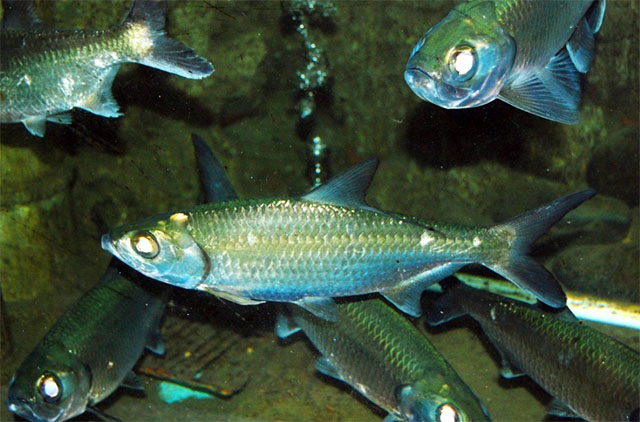| Megalopidae (Tarpons) |
| 150 cm TL (male/unsexed); max.weight: 18 kg; max. reported age: 44 years |
|
benthopelagic; freshwater; brackish; marine; depth range 1 - 50 m, amphidromous |
| Indo-Pacific: Persian Gulf (Ref. 68964), Red Sea and Natal, South Africa (Ref. 3969) to the Society Islands, north to southern Korea, south to the Arafura Sea (Ref. 9819) and New South Wales. Restricted to high islands (Palau, Caroline and Mariana islands) in Micronesia. Reported as far inland as the lower Shire in Malawi and the Save-Runde junction in Zimbabwe (Ref. 7248, 52193). Widespread in the Lower Zambezi River channels up to Marromeu and in the Micelo River up to Malingapanzi (Ref. 39494). South China Sea, Taiwan Strait, and East China Sea(Ref.33302). |
|
Dorsal spines (total): 0-0; Dorsal soft rays (total): 16-21; Anal spines: 0-0; Anal soft rays: 23-31. Description: Body streamlined and compressed (Ref. 52193). Eye large; mouth large, lower jaw projects beyond snout; a bony gular plate present between the jaw bones; teeth extremely fine (Ref. 52193, 10982). Dorsal fin with 16-21 rays; anal fin with 23-31 rays; dorsal fin with last fin ray extended into a long filament, directly over pelvic fins; pectoral fins low on side of body near ventral margin; abdominal pelvic fins with 9 or more rays; caudal fin deeply forked (Ref. 52193, 10982). Scales large; lateral line scales 36-42; prominent elongate scales at base of paired fins; head without scales (Ref. 52193, 10982). Can tolerate oxygen-poor water by 'breathing' air into a modified lung-like swimbladder (Ref. 10982). Colouration: Blue-green dorsally; silver on sides (Ref. 10982). |
| Adults are generally found at sea, but young inhabit river mouths, inner bays, and mangrove forests. In freshwater, they occur in rivers, lagoons, lakes, and swampy backwaters (Ref. 2847, 44894). Tolerate a wide pH range (5.2-9.1) (Ref. 44894) and salinities from 0 to 100. Mainly diurnal (Ref. 7017). Predaceous, feeding mainly on fishes and crustaceans (Ref. 5213). Breed offshore, possibly throughout the year. Larvae are transparent and resemble larval eels (Ref. 13337), but with a forked tail (Ref. 167). Juveniles commonly enter freshwater (Ref. 44894, 48635) in clear or turbid water (Ref. 44894). Known to breath air, rising regularly to the surface to do so. Cultured in ponds, the fry being sourced from the coasts (Ref. 7050). Popular angling fish (Ref. 3969). Edible but not esteemed (Ref. 3969). Caught by gill nets, seines, and trawls, and by hook-and-line; marketed fresh and dried salted (Ref. 10982). |
|
Data deficient (DD); Date assessed: 29 June 2016 Ref. (130435)
|
| harmless |
Source and more info: www.fishbase.org. For personal, classroom, and other internal use only. Not for publication.
